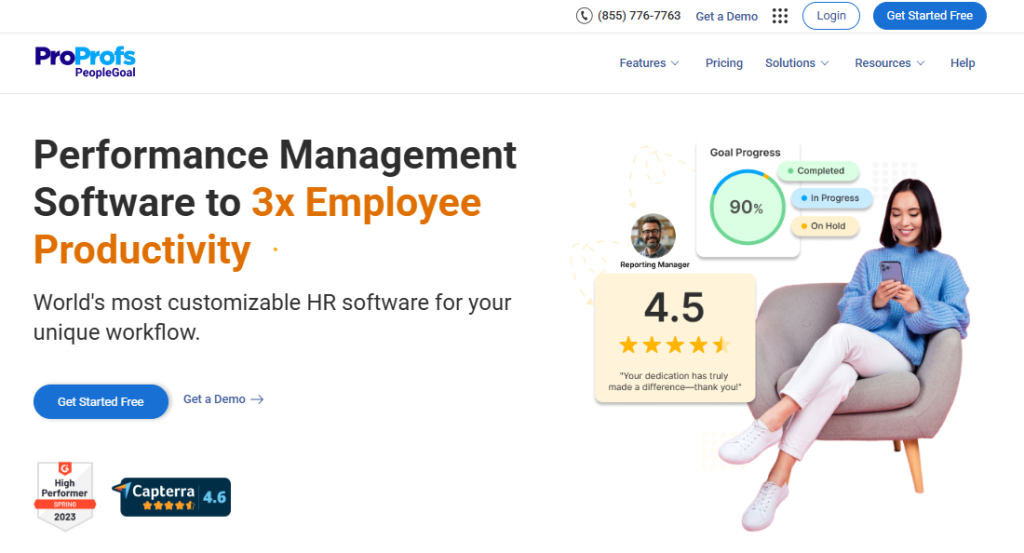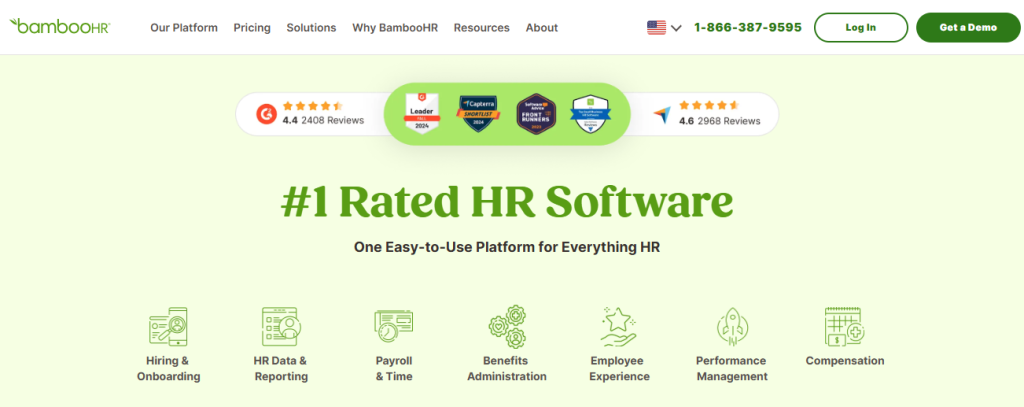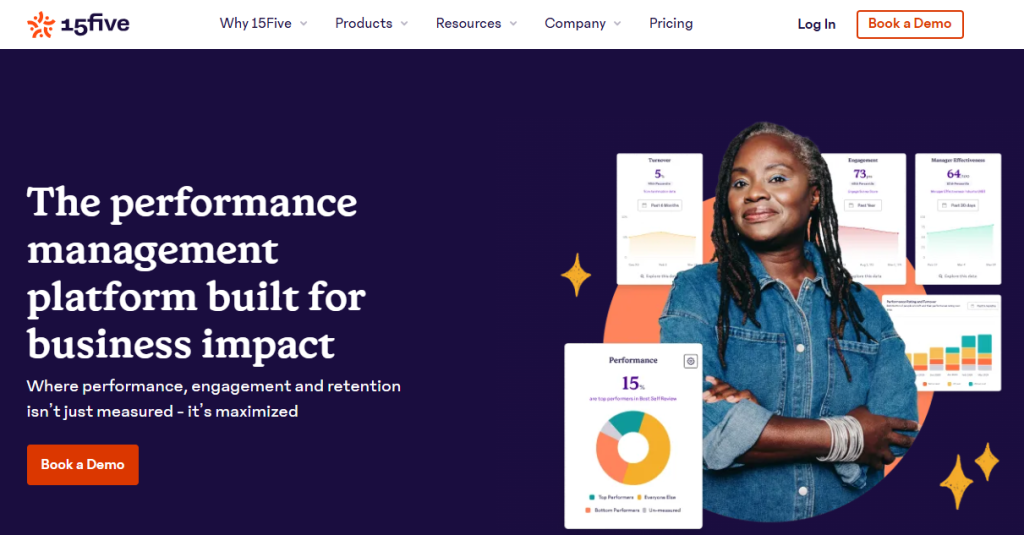Growing businesses face a common challenge: keeping track of employee performance while building a strong team culture. Traditional annual reviews and spreadsheets don’t cut it anymore. Modern performance management software helps organizations create structured feedback loops, set clear goals, and track progress throughout the year. These digital tools transform how companies approach talent development and employee engagement. With the right platform, businesses can shift from reactive to proactive performance strategies that drive real results.
What Is Performance Management Software?
Performance management software is a digital platform that helps organizations set goals, track progress, and evaluate employee performance in real time. Instead of relying on spreadsheets or once-a-year reviews, these tools provide a structured way to capture feedback, manage objectives, and analyze results through dashboards and reporting features.
Modern systems often include:
- Goal setting and alignment with business objectives
- Continuous feedback loops
- 360-degree evaluations
- Analytics and trend reporting
- Integration with HR platforms
A performance management platform makes performance data visible and actionable by offering managers, employees, and HR teams one centralized system.
Top 7 Performance Management Software Solutions
The market for performance management software is wide, but not every platform suits every business. Below are seven solutions that stand out in 2025, each bringing its own strengths depending on company size, structure, and goals.
1. PeopleGoal

PeopleGoal is a fully customizable performance management software that helps organizations align goals, feedback, and development in one place. It combines OKRs, SMART goals, cascading tasks, and 360 feedback with real-time dashboards that give HR visibility into performance trends. What sets it apart is the dedicated App Store, packed with ready-to-use apps for onboarding, engagement, and growth.
Key Features:
- Customizable OKRs and SMART goals with real-time tracking
- 360° feedback from multiple sources
- App Store with ready templates and workflows
- Cascading goals from the company to the individual level
Pros:
- Pre-built apps cut setup and rollout time
- Clear alignment from executives to individual contributors
- Easy integration with existing HR systems
Cons:
- No downloadable or on-premise version
- Dark user interface option is not available
2. BambooHR

BambooHR connects performance management with broader HR functions in one integrated platform. It offers goal tracking, reviews, and employee development planning tools. The platform is known for its ease of use, especially for small to midsize companies. Since it sits within BambooHR’s wider HR suite, performance data flows seamlessly into payroll, records, and other core functions.
Key features:
- Goal tracking, performance reviews, and 360° feedback
- Customizable review cycles
- Career development and pathing tools
- Integration with payroll and HR records
Pros:
- Works seamlessly with payroll, benefits, and HR systems
- Simple interface suited for small to midsize companies
- Strong reporting for tracking progress
Cons:
- Limited advanced analytics vs. specialized tools
- Fewer customization options for complex org structures
3. Lattice

Lattice emphasizes ongoing feedback and development. The platform combines performance reviews, goal-setting tools, and OKR frameworks with employee engagement features. Pulse surveys and analytics give leaders a view of both performance and morale, helping managers understand how employees are feeling while tracking measurable outcomes.
Key features:
- Continuous feedback loops, 1:1 templates, and 360° feedback
- AI insights for coaching and skill gap support
- Pulse surveys and engagement tracking
- OKR framework with team goal alignment
Pros:
- Strong emphasis on ongoing feedback and development
- Customizable multi-stakeholder reviews
- Advanced analytics linking performance and engagement
Cons:
- May feel complex for basic tracking needs
- Setup can take time to unlock full value
4. 15Five

15Five builds performance management around weekly check-ins. Instead of waiting for quarterly or annual reviews, employees share short updates that keep managers in the loop. The platform also includes OKR tracking, recognition tools, and feedback features that encourage consistent conversations. Its strength lies in keeping communication lightweight but regular.
Key features:
- Weekly check-ins with structured updates
- OKR tracking and goal alignment
- Peer recognition and feedback
- Designed for frequent check-ins and goal tracking
Pros:
- Improves engagement through better communication
- Lightweight, easy-to-use performance management
- Promotes regular manager-employee feedback
Cons:
- Limited advanced reporting and analytics
- Frequent check-ins may feel repetitive for some employees
5. Culture Amp
Culture Amp combines performance management software with employee engagement surveys and analytics. The platform highlights how workplace culture impacts performance outcomes. With benchmarking data, organizations can compare their practices to industry standards, giving HR teams insights into both strengths and areas for improvement.
Key features:
- Engagement surveys with industry benchmarks
- Culture-focused performance reviews
- Real-time feedback and pulse surveys
- Manager coaching and development tools
Pros:
- Strong emphasis on culture and engagement
- Benchmarking against industry standards
- Powerful analytics connecting culture to outcomes
Cons:
- Performance management is secondary
- Not focused on culture for companies
6. Workday HCM
Workday delivers performance management as part of its enterprise HCM suite. It includes advanced reporting, AI-driven insights, and deep integration with workforce planning tools. This makes it well-suited for large organizations that need to manage complex structures and multiple business units.
Key features:
- Adaptive platform with user-friendly design
- AI-driven insights and predictive analytics
- Customizable dashboards and advanced reporting
- Integrates with workforce planning and talent management
Pros:
- Enterprise-grade HCM with comprehensive capabilities
- Scales well for large, complex organizations
- Strong AI and analytics for strategic decisions
Cons:
- High cost and complex implementation
- Too heavy for small to midsize businesses
7. SAP SuccessFactors
SAP SuccessFactors is designed for multinational enterprises that require structured, compliant performance management processes. Its platform includes calibration tools for fair performance ratings, succession planning features, and reporting dashboards that connect daily performance with long-term workforce strategy.
Key features:
- Full HCM suite with global compliance support
- Performance calibration for consistent ratings
- Succession planning and talent pipeline tools
- Multi-language and multi-currency support
Pros:
- Strong Core Employee Central functionality
- GDPR compliance with audit tracking for regulated industries
- Scales effectively for global enterprises
Cons:
- Complex setup and high ownership costs
- Steep learning curve requiring extensive training
Why Do Organizations Need Performance Management Software?
As companies grow, performance challenges multiply. What works for a small team often breaks down once headcount expands. Below are the most common hurdles fast-growing organizations face, and how performance management software helps solve them.
1. Scalability Crisis
When a company jumps from 20 employees to 200, manual processes collapse. Goals get fuzzy, expectations are unclear, and leadership struggles to track progress. Without structure, growth creates confusion instead of momentum.
How software helps: Scalable performance management platforms automate review cycles, standardize processes, and keep systems consistent no matter the team size. Look for tools with flexible pricing, solid architecture, and proven success in large organizations.
2. Fragmented Systems and Shadow Processes
Departments often create their own “shadow systems,” informal spreadsheets, ad hoc trackers, or inconsistent review methods. This fragmentation makes it hard to see the big picture.
How software helps: A centralized performance management platform becomes the single source of truth. It unifies data, reduces duplication, and ensures everyone follows the same standards across the business.
3. Goal Misalignment Across Teams
As organizations grow, individual goals can drift away from company priorities. Teams may head in different directions, leading to duplicated effort and conflicting outcomes. This lack of alignment makes it harder for leadership to track progress and for employees to see the impact of their work.
How software helps: Modern platforms support cascading goals, linking corporate objectives down to team and individual targets. This ensures employees know how their work connects to the bigger mission.
4. Inconsistent Feedback and Development
Managers in growing companies get stretched thin. Employees then receive irregular feedback and lose clarity on their career development. Over time, this leads to frustration and disengagement.
How software helps: Performance management software builds structured feedback cycles. Automated reminders, coaching templates, and check-in schedules ensure development conversations happen consistently.
5. Remote and Hybrid Workforce Management
Remote and hybrid work models break the old habit of face-to-face reviews. Managers can’t rely on casual office conversations to gauge performance anymore.
How software helps: Cloud-based systems track contributions from anywhere, enable virtual check-ins, and support asynchronous feedback. This makes performance conversations possible even across time zones.
6. Gaps in Data-Driven Decisions
Without analytics, decisions about promotions, raises, or training often involve guesswork, which can undermine productivity, satisfaction, and retention.
How software helps: Performance management tools deliver dashboards that highlight trends, spot high performers, and flag areas of risk. Data-driven insights replace bias with measurable results.
Selecting Performance Management Software Based on Growth Stage
The performance management software you choose should match your company’s size and maturity. A tool that works well for a startup may not be enough for a fast-scaling enterprise. Here’s how the right features change with each stage of growth.
Early-Stage Companies (10–50 Employees)
At this stage, keep it simple. Look for performance management software with easy goal-setting, quick review templates, and mobile access. Flexible pricing and minimal admin overhead make it easier to build consistent feedback habits.
Scaling Organizations (50–200 Employees)
As teams grow, consistency across departments becomes critical. Performance management tools should support customizable workflows, role-based permissions, and integrations with HR or project systems. Features like coaching guides help new managers provide quality feedback.
Established Growth Companies (200–500 Employees)
Larger structures need more advanced features. Prioritize platforms with strong analytics, compliance support, and 360-degree feedback. These insights help leaders make decisions on promotions, retention, and succession planning.
Rapid Expansion (500+ Employees)
At enterprise scale, performance management platforms become strategic systems. Look for robust APIs, enterprise-grade security, and global scalability. Integration with LMS, compensation, and BI tools creates a complete talent ecosystem.
From Reviews to Real Impact: The Next Step
Performance management software transforms how organizations develop their people and drive business results. The right platform creates structured feedback loops, supports continuous improvement, and provides valuable insights about team performance trends. Success depends on selecting tools that match your company’s culture, size, and specific needs. Take time to evaluate different options carefully, considering both current requirements and future growth plans. With proper implementation and adoption, these digital tools can significantly improve employee engagement and organizational performance.


This blog offers a very balanced and practical overview of today’s leading performance management software, especially useful for growing organizations that are outgrowing spreadsheets and ad-hoc reviews. I like how it clearly explains what performance management tools actually do and then compares platforms like PeopleGoal, BambooHR, Lattice, 15Five, Culture Amp, Workday, and SAP SuccessFactors with honest pros and cons instead of just marketing language. The sections on common scaling challenges—such as fragmented systems, goal misalignment, and inconsistent feedback—and how software solves them make the article particularly actionable for HR leaders and founders. Overall, it’s a very helpful guide for selecting the right tool based on company size, culture, and growth stage.